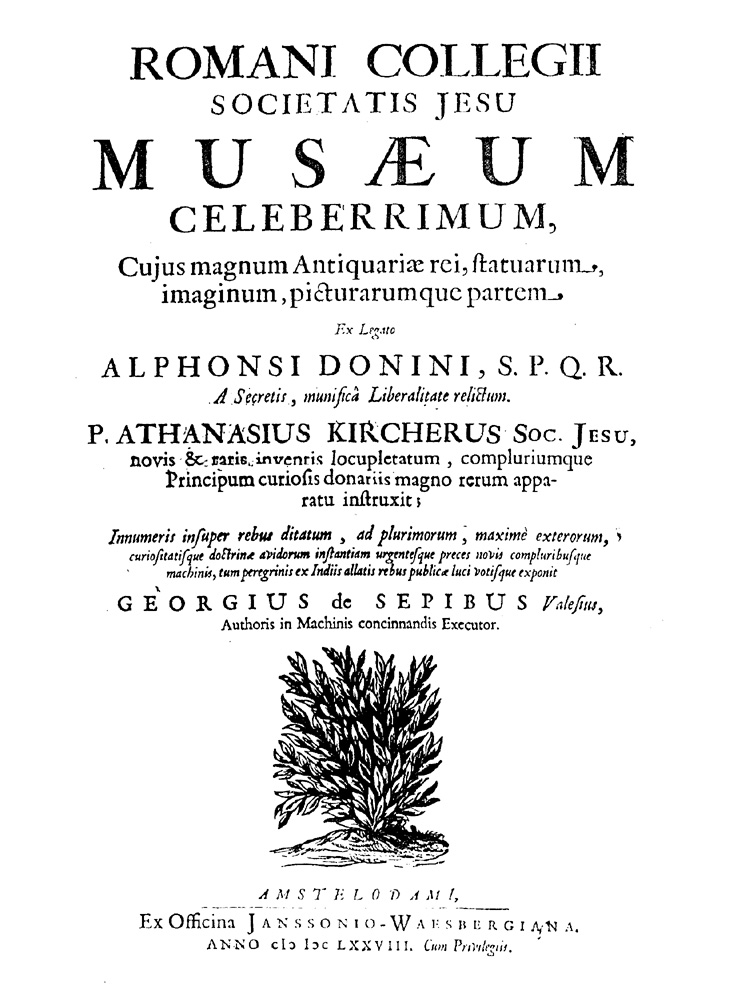SEPI, Giorgio de.
(1645? – ?)

1. Latin, 1678.
Romani Collegii | Societatus Jesu | Musæum | Celeberrimum, Cujus magnum Antiquariæ rei, statuarum., | imaginum, picturarumque partem. | Ex Legato | Alphonsi Donini, S.P.Q.R. | A Secretis, munificâ Liberalitate relictum. | P. Athanasius Kircerus Soc. Jesu, | novis & raris inventis locupletatum, compluriumque | Principum curiosis donariis magno rerum appa- | ratu instruxit; | Innumeris insuper rebus ditatum, ad plurimorum , maximè exterorum, | curiositatisque doctrinæ avidorum instantiam urgentesque preces novis compluribusque | machinis, tum peregrinis ex Indiis allatis rebus publicæ luci votisque exponit | Georgius de Sepibus Valesius, | Authoris in Machinis concinnandis Executor. | [ornament] | Amstelodami, | [rule] | Ex Officina Janssonio-Waesbergiana. | Anno cI{[Backwards c] I[Backwards c]c LXXVIII}. Cum Privilegiis.
2°: *4 A-I4 (including engraved title page); 40l.; [8], 1-66, [6] p., 19 engraved plates (some fold.), illus. Engraved title page. Page size: 390 x ?? mm.
Contents: [2 pgs], Engraved title page, verso blank.; [2 pgs], Printed title page, verso "Kircheri Tempe fœcundo germine culta, | ..."; [2 pgs], Dedication by A. Kircher to D. Joanni, dated 25 January 1678.; [1 pg], "Curioso Lectori | S.P.D. | Georgius de Sepibus."; [1 pg], "Index Contentorum | In Hoc Libro."; 1-66, Text.; [5 pgs], "Index Rerum."; [1 pg], "Index | Figurarum, | In | Musæo Kircheriano | suis locis inserendorum."
Plates: None of the plates appears to be signed. The 19 engravings consist of: The engraved title page showing the museums interior [see commentary for description]. Page 8, folding, showing characters from the Sanskrit and Chinese languages. Page 10A & 10B, folding, show details of Eygyptian obelisks. Page 12A, 12B & 12C, folding, show details of Eygyptian obelisks. Page 12D & 12E, not folding, show details of Eygyptian obelisks. Page 37, depict various figures including the Holy Arc and a cabinet of coins(?). Page 38, illustrates various optical principals. Page 40A, show the reflection and focusing of sun beams. Page 40B & 40C, illustrate, "Horologium Hydraulicum." Page 40D, shows "Horologium Multiplex."
Rare. This finely illustrated work is the first published catalog of the celebrated Museo Kicheriano in the Jesuit Collegio Romano. The nucleus of the collection came in 1651 when the secretary of the Roman senate, Alfonso Donino [ -1651], bequeathed his collection of classical antiquities to the Collegio Romano. Kircher was appointed curator of the Donino collection, and he used the position to enlarge it with exotic items from Eygpt, the Far East and the Americas. Gradually mathematical instruments, other scientific instruments, models of Egyptian obelisks, musical instruments and hydraulic organs were added. Clocks, preserved examples of birds and animals, geological specimens and works of art all soon followed. During Kircher's many travels, he routinely sought out new material to add to the growing accumulation. An additional productive source of material for the Museo Kircheriano was the network of Jesuit missionaries scattered throughout the world. They would regularly send back to Rome example of the native flora, fauna, minerals, and everyday tools. Soon the Musæum Kircherianum as the collection became known was the finest of its kind in the world.
It was displayed in a hall in the Collegio in Rome. As material was added more space was acquired. Soon it became necessary for Kircher to hire several assistant custodians. Best known of these was Giorgio de Sepi, author of this first account of the museum. Its arrangement is in accordance with the physical outlay of the collection and it describes and illustrates Egyptian and classical artifacts, musical instruments, plants, grasses, insects, preserved animals and birds, some minerals and petrifications scientific instruments including early lighting devices. The remarkable engraved title page provides a unique view of the museum's interior at its greatest period. At intervals along the center of the long hall were free standing statuary and models of Egyptian obelisks, with shelving along one wall to accommodate pottery and other artifacts. Glass display cases held the smaller or fragile specimens along the opposite wall. Space above the cases was reserved for paintings, preserved animals, weapons, and scientific apparatus. The high ceiling was decorated with paintings of the constellations and the signs of the zodiac. A large Nile crocodile is also seen suspended, perhaps inspiring Ferrante Imperato's own display. Near the hall's entrance, a human skeleton appears to great visitors. Several visitors are depicted with Kircher himself proudly showing off the collection. Other plates in the book illustrate the Sanskrit and Chinese alphabets, Eygyptian obelisks, various scientific principles, and mechanical apparatus. Text illustrations show a wide variety of animals, coins, a compass(?) and water wheel.
Bibliographical references: Bedini, S.A., "Cidtadels of learning. The Museo Kircheriano and other seventeenth century Italian science collections" (pp. 249-67), in: Casciato, M., M.G. Ianniello, and M. Vitale, M., eds., Enciclopedismo in Roma Barocca. Athanasius Kircher e il Museo del Collegio Romano tra Wunderkammer e museo scientifico. Venezia, Marsiolio Editori, 1986. [1]-376 p., illus., biblio. • Caillet, Manuel, 1912: no. 5784. • Freilich Sale Catalog: no. 310. • Gatterer, Mineralogischen Literatur, 1798-9: 1, 279-80. • Murray, Museums, 1904: 1, 106 & 3, 133. • Schupbach, Cabinets in European Academies, 1985: 174-5.
.